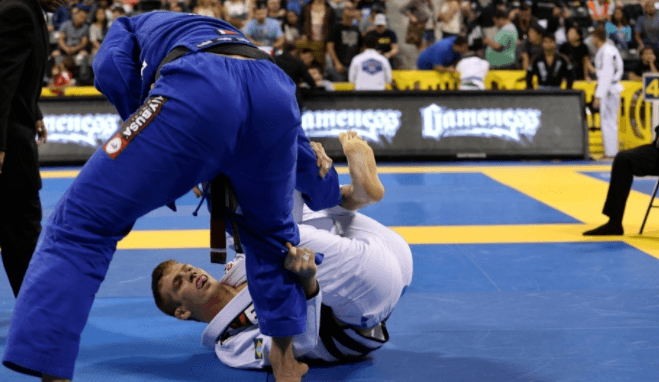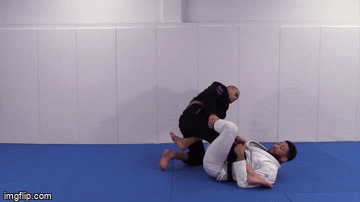
Sweeping in Jiu-Jitsu is fun. The looks on people’s faces when they’re powerless to stay up as they realize they’re tumbling to the ground are always priceless. However, sweeps are not an easy thing to get, particularly against skilled and seasoned opponents. In that sense, the majority of sweeps in Brazilian JIu-JItsu come from open guards, given all the variety that is available from there. So, open guard sweeps are the things to focus on, but which ones? There’s no simple answer that will provide two or three sweeps that will universally work against everyone. There is, however an answer to that question.
Open guard sweeps come in as many different variations as there are guards. That doesn’t really help the case for figuring out how to sweep everyone you roll or fight with. Sweeps do have common underlying principles that make them work, but that is a subject for another day. In terms of practicality, you need to focus on sweeping people that are constantly changing levels. It is easy to sweep someone who is not defending the sweep, but it is highly unlikely to expect such a scenario every time you try a sweep.
Why Do We Sweep?
The main question here is why do we need to sweep in the first place? In Brazilian Jiu-Jitsu, the guard is a signature position that everyone falls in love with at a certain point in time. However, there are only two things, offensively speaking, that you can do from the guard. You can submit an opponent, which would be the most desirable outcome. It also happens to be the headrest thing to accomplish in Jiu-Jitsu. Apart from submitting someone, all that you’re left with is sweeping. But what does a sweep get you, exactly?

Open guard sweeps help you achieve this very thing – earn top position. Let’s face it; you won’t do much if you’re stuck on the bottom. Even in terms of submissions, finishing form top positions is far more high percentage than doing so from the guard. To that extent, as a general rule of thumb, you want to finish submissions from the top, even when you set them up from guards.
So, in short, sweeping allows you to actually be able to score, control, submit or strike by getting you the one thing we’re all after in grappling – top position.
Open Guard Sweeps
There are plenty of ways to try and categorize open guard sweeps. You could do so by type of guard, type of sweep, via general principles that certain sweeps share or any way you see fit. However, my proffered method is to organize them according to what the opponent does. In fact, it is not so much what they do, as where they are.
When you’re in guard, the top person has to pass the legs to do anything meaningful. To achieve that, they’ll have to fend off all your sweep and submission attacks. One of the most fundamental ways of trying to confuse a guard player, and force them to change their game is by changing levels. What that means is that a top person can stand with both feet on the ground, half-kneel with one knee and one foot on the ground, or keep both knees on the ground. The thing with these levels is that no one sweep works against all there levels. So, organizing your open guard sweeps according to the level which the opponent is at is the best way to make sure you react on time, and with the appropriate move.
Level 1: Standing
First off, let’s see what happens when an opponent is standing. To be fair, in the modern BJJ game, people like to stand when they face a guard most of the time. This does provide them with a lot of different passing options, but it also has weaknesses that you can exploit when looking for open guard sweeps.

Grips are crucial in helping you keep the posture broken. The posture is key to the opponent’s balance, so make sure you use both hands to grip the Gi sleeves or the wrists in order to keep the posture broken. This will allow you to do a simple trip with your legs, whether it is backward or to the sides. More importantly, the grips you have will allow you to pull yourself up after the trip, thus completing the sweep and gaining top position.
Level 2: Half-Kneeling
Sweeping against a half-kneeling opponent is usually the hardest level to sweep from. The reason for this is the base of the opponent is very wide and low, and they have the option to switch back to either of the two other levels immediately.

Just as an example, we’ll go over the stand-up sweep from there. As long as you can get the leg that has the foot on the ground on your shoulder, all you really need to do is a technical stand up. The principle here is that you’re forcing them to balance only on the leg that has the knee down. Even if you’re not going for this sweep, or aren’t even in the Single leg-X, the same principle applies – lift the leg that you can manipulate, and force them to balance on their knee.
Level 3: Kneeling

The example is going to be a butterfly guard sweep (obviously). The goal is simple – try to shift the opponent’s weight wither forward or back, as far as possible. The way to achieve this is by using one of their arms as a lever – with an arm drag, overhook, underhook or a 2-on-1 grip. As long as you get the opponent’s center of gravity away from their knee line, you can easily transition to top position using any butterfly sweep you want.
Wrap Up
The above three sweeps are just an example of what you can do when an opponent is at a different level of the top position. The key thing to remember is that seasoned opponents will change between level. When you’re thinking about perfecting your open guard sweeps look to use weeps that easily tie into each other, depending on what level the opponent is at. The fewer adjustments it takes when an opponent changes levels, the easier it will be to gain that much-coveted top position.


![Darce Choke Encyclopedia – Origins, Mechanics and Variations [2025] BJJ, choke, Brabo, BJJ Darce Choke, D'arce Choke, Darce BJJ Choke](https://bjj-world.com/wp-content/uploads/2017/11/JungPoirierLeeYahoo-218x150.jpg)









![Get Off My Legs Gringo Craig Jones DVD Review [2025] Get Off My Legs Gringo Craig Jones DVD Review](https://bjj-world.com/wp-content/uploads/2025/03/get-off-my-legs-gringo-craig-jones-dvd-review-218x150.png)

![Leg Lock Entries Helena Crevar DVD Review [2025] Leg Lock Entries Helena Crevar DVD Review](https://bjj-world.com/wp-content/uploads/2025/03/leg-lock-entries-helena-crevar-dvd-review-218x150.png)
![Special K Guard Neil Melanson DVD Review [2025] Special K Guard Neil Melanson DVD Review](https://bjj-world.com/wp-content/uploads/2025/03/special-k-guard-neil-melanson-dvd-review-218x150.png)
![Arm Bar It All Shawn Melanson DVD Review [2025] Arm Bar It All Shawn Melanson DVD Review](https://bjj-world.com/wp-content/uploads/2025/03/arm-bar-it-all-shawn-melanson-dvd-review-218x150.png)

![Creating Back Exposure Luke Griffith DVD Review [2025] Creating Back Exposure Luke Griffith DVD Review](https://bjj-world.com/wp-content/uploads/2025/01/creating-back-exposure-luke-griffith-dvd-review-324x235.png)
![360 Degrees Guard Retention Thiago Abud DVD Review [2024] 360 Degrees Guard Retention Thiago Abud DVD Review](https://bjj-world.com/wp-content/uploads/2024/10/360-degrees-guard-retention-thiago-abud-dvd-review-100x70.png)

![Higher Tripod Passing Craig Jones DVD Review [2025] Higher Tripod Passing Craig Jones DVD Review](https://bjj-world.com/wp-content/uploads/2025/02/higher-tripod-passing-craig-jones-dvd-review-100x70.png)


![Baby Shark Guard System Diogo Reis DVD Review [2025] Baby Shark Guard System Diogo Reis DVD Review](https://bjj-world.com/wp-content/uploads/2025/02/baby-shark-guard-system-diogo-reis-dvd-review-100x70.png)
![Neil Melanson DVD Bundle Review: Filthy Brutal No Good Attacks [2024] Neil Melanson DVD Bundle Review: Filthy Brutal No Good Attacks](https://bjj-world.com/wp-content/uploads/2024/10/neil-melanson-dvd-bundle-review-filthy-attacks-100x70.png)
![Osoto Gari for Jiu Jitsu Jackson Nagai DVD Review [2024] Osoto Gari for Jiu Jitsu Jackson Nagai DVD Review](https://bjj-world.com/wp-content/uploads/2024/10/osoto-gari-for-jiu-jitsu-jackson-nagai-dvd-review-100x70.png)
![Closed Guard Reintroduced Adam Wardzinski DVD Review [2025] Closed Guard Reintroduced Adam Wardzinski DVD Review](https://bjj-world.com/wp-content/uploads/2025/01/closed-guard-reintroduced-adam-wardzinski-dvd-review-100x70.png)


![Leg Lock Stock And Barrel Taylor Pearman DVD Review [2025] Leg Lock Stock And Barrel Taylor Pearman DVD Review](https://bjj-world.com/wp-content/uploads/2025/03/leg-lock-stock-and-barrel-taylor-pearman-dvd-review-100x70.png)
![Kill The Underhook Dima Murovanni DVD Review [2024] Kill The Underhook Dima Murovanni DVD Review](https://bjj-world.com/wp-content/uploads/2024/10/kill-the-underhook-dima-murovanni-dvd-review-100x70.png)

![Slip N Slide Into Victory Julián Espinosa DVD Review [2025] Slip N Slide Into Victory Julián Espinosa DVD Review](https://bjj-world.com/wp-content/uploads/2025/01/slip-n-slide-into-victory-julian-espinosa-dvd-review-100x70.png)

![Full Guard Formula James Booth DVD Review [2025] Full Guard Formula James Booth DVD Review](https://bjj-world.com/wp-content/uploads/2025/02/full-guard-formula-james-booth-dvd-review-100x70.png)
![Complete Front Headlock System Michael Pixley DVD Review [2024] Complete Front Headlock System Michael Pixley DVD Review](https://bjj-world.com/wp-content/uploads/2024/10/front-headlock-system-michael-pixley-dvd-review-100x70.png)
![The Bear Trap Nicolas Renier DVD Review [2025] The Bear Trap Nicolas Renier DVD Review](https://bjj-world.com/wp-content/uploads/2025/01/the-bear-trap-nicolas-renier-dvd-review-100x70.png)
![Basic Closed Guard Jasmine Rocha DVD Review [2024] Basic Closed Guard Jasmine Rocha DVD Review](https://bjj-world.com/wp-content/uploads/2024/11/basic-closed-guard-jasmine-rocha-dvd-review-100x70.png)

![Dynamic Headquarters Passing Jason Rau DVD Review [2024] Dynamic Headquarters Passing Jason Rau DVD Review](https://bjj-world.com/wp-content/uploads/2024/10/dynamic-headquarters-passing-jason-rau-dvd-review-100x70.png)
![Standing Leg Entries Alex West DVD Review [2025] Standing Leg Entries Alex West DVD Review](https://bjj-world.com/wp-content/uploads/2025/03/standing-leg-entries-alex-west-dvd-review-100x70.png)


